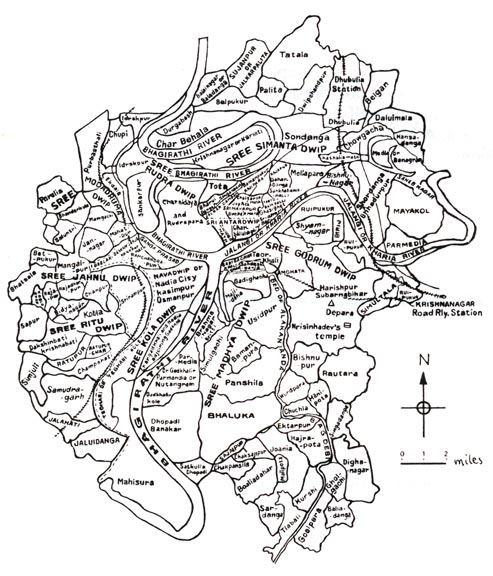(The Harmonist, Vol.29 Sept. 1931)

Map of Sridhama Navadvipa
We have dealt with the question of the identification of the geographical site of the birth of Sri Caitanya from the antiquarian's point of view, in a previous number of this journal. In another article we tried to explain why the circumambulation of the Holy Site possesses an abiding spiritual value for all persons.
The identification of many of the sites has been rendered comparatively easy by the survival of the old place names. This is as was to be expected in the case of a place which is only four centuries old. In the Bhakti-ratnakara we find the corroboration, from on old source of the truth of the relative positions of these locally recognizable sites. As we pointed out in the previous article the actual Site of Birth of the Lord is definitely remembered by the inhabitants to the present day. The memory of the Holy Site has been further preserved by the growth of many an interesting legend round the site. This also was noticed in the article referred to.
As soon as we are thus enabled to identify the Site of the 'House of God' to quote the language of Bhakti-ratnakara, we can follow and identify the details of the route of circumambulation given in that work of Sridhama Navadvipa by Srinivasa Acarya in the company of Isana Thakura who was in charge of the household of the Lord shortly after His disappearance. The places visited were Atopura adjoining Mayapura which, said Thakura Isana, formerly bore the name of Antardvipa. The place bearing locally the designation of Atopura did not disappear in the bed of the Bhagirathi till quite recently. It adjoined the identified Site of Mayapura. On leaving the 'House of God' Isana Thakura pointed out to his companion the ancient site of Suvarnabihar which could be seen in the distance from the neighborhood of the 'House of God,' This agrees perfectly with the position the site as identified. It may be noted in this connection that the ancient 'mound of Suvarnabihar is a prominent object as seen from a place adjoining the 'House of God' and even the most casual observer was not likely to miss the sight. The almost dramatic suddenness with which the historic mound burst on the view of the observer as he left the 'House of God' could not fail to excite curiosity in those days when the magnificent old ruins were still intact. The Kholobhanga- danga i.e. the mound where the khol of the first chanters of kirtana was broken is easily identifiable from the narrative, of the Caitanya-bhagavata with the yard of Srinivasa.
The traditional site of Kholbhanga-danga is identifiable quite close to the site of Birth. This relative position is corroborated by numerous references, in various connections in Sri Caitanya-bhagavata.
From Kholbhanga-danga, the distance of the home of Sridhara could not have been very far. When Sridhara was sent for from the house of Srivasa Pandita the devotees who went to bring him heard his loud voice reciting the Name of Hari when they had proceeded only half the way. Sridhara was accustomed to chant the Name of Hari with a very loud voice. The voice of Sridhara was heard long before the boundary of the village (Mayapura) was reached. We are told elsewhere, in the description of the route of the first processional kirtana along the street of the town, that the house of Sridhara was visited on the route between the house of the Kazi and Gadi-gachha. The position of Gadi-gachha is given in the Settlement maps as adjoining Mayapura. The village has since shifted its position on account of the change in the riverbed and one part of it now bears the name of Mahesganj. The house of the Kazi is still in Baman-pukura.
The Kayastha-koustubha quotes from the Urddhamnaya-tantra a passage regarding the Appearance of Mahaprabhu son of Saci at Mayapur (p.98). The book was published eighty-six years ago by Raja Rajendra Nath Mitra of Andul. The same work also quoted from Ananta-samhita that the Supreme Lord will be born from the womb of Saci at Navadvipa (p. 124, 130). On page 123 the writer takes the trouble to explain that Mayapura was another name of Navadvipa where Laksmana Sena had built his capital. The tradition recorded by Hunter in his Statistical Account (1880) is that "It (Nadia) was on the East of the Bhagirathi and on the West of the Jalangi" (p. 142). The changes in the course of the Bhagirathi may be studied in the History of Nadia Rivers, the Map of Suba Bangla, Renell's Map and Blochmann's Map. They throw some light on the obscure point how the name Navadvipa was gradually shifted by the pressure of the changing river to the present town of Navadvipa on the West side of the Bhagirathi.




